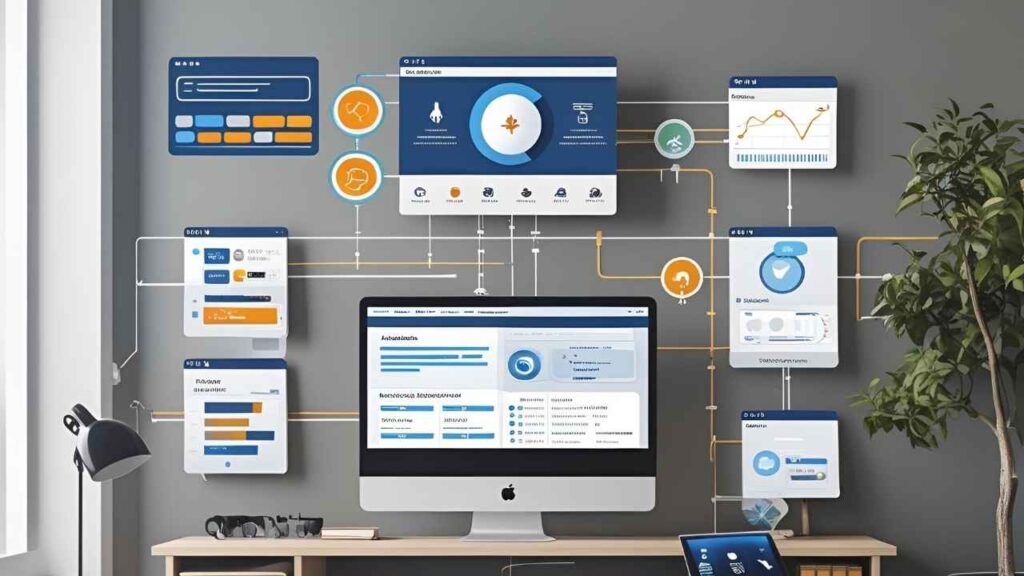Application monitoring tools are needed to provide availability, performance, and reliability of contemporary applications. Application monitoring software enables companies to monitor application well-being, performance bottlenecks, and problems before their discovery by users. They offer insights into application response time, error rates, resource utilization, and user perception, thus providing high-quality services.
IT operations personnel, developers, DevOps professionals, system administrators, and business analysts comprise the key users of application monitoring solutions. Developers use them to debug and optimize code, while IT personnel use them to avert downtime and provide seamless application performance.
These 15 best application monitoring tools are selected against some of the most important parameters such as monitoring in real-time, scalability, ease of interoperating with cloud and on-premise infrastructure, end-to-end reporting and analysis, support for automation, and cost. Solutions range from one level of monitoring to another which includes infrastructure and logs to end-user experience to predictive analytics through AI. In both small as well as big businesses, these tools assist in enhancing system performance, minimizing downtime, and delivering enhanced overall user satisfaction.
Criteria for Selecting the Best Application Monitoring Tools
Now comes the question of choosing the best application monitoring tool involves several key factors to ensure optimal performance, reliability, and usability. The following are the most significant criteria that are embraced in the best application monitoring tools selection:
- Real-Time Monitoring & Alerts: The application should provide real-time monitoring of app performance, latency, and errors, and real-time alerts for instant fixes.
- Scalability & Flexibility: The quality monitoring solution must be able to scale with growing infrastructure and support various environments like on-premises, cloud, and hybrid environments.
- Ease of Integration: Support for existing DevOps tools, cloud providers (AWS, Azure, Google Cloud), CI/CD pipelines, and third-party apps allows for effortless deployment.
- End-to-end Performance Metrics: Monitoring server health, database query, API performance, and user experience metrics gives insightful end-to-end visibility.
- AI & Automation Features: Advanced tools leverage AI-enabled anomaly detection and automated root cause resolution for proactive monitoring optimization.
- Log Management & Analytics: The ability to collect, analyze, and correlate logs with performance data makes possible issues diagnosis and application efficiency optimized.
- User Experience Monitoring (UEM): Real-time user behavior monitoring, session replay, and performance analytics capabilities improve applications’ user-friendliness.
- Custom Dashboards & Reporting: A clean UI with custom dashboards and detailed reporting allows teams to visualize and act on key data efficiently.
- Security & Compliance: The app should have secure data handling, role-based permissions, and compliance with industry regulatory standards (GDPR, HIPAA, SOC 2).
- Cost-Effectiveness & Pricing Models: This is crucial for business firms of varying sizes and requirements to balance features, price, and value.
These requirements recognize products that offer good application performance monitoring (APM) to support hassle-free application functioning, reduce downtime, and improve end-user experience.
List of 14 Best Application Monitoring Tools
Let’s discuss the features, pros, cons and pricing details of the best application monitoring tools available in the market:
1. Datadog
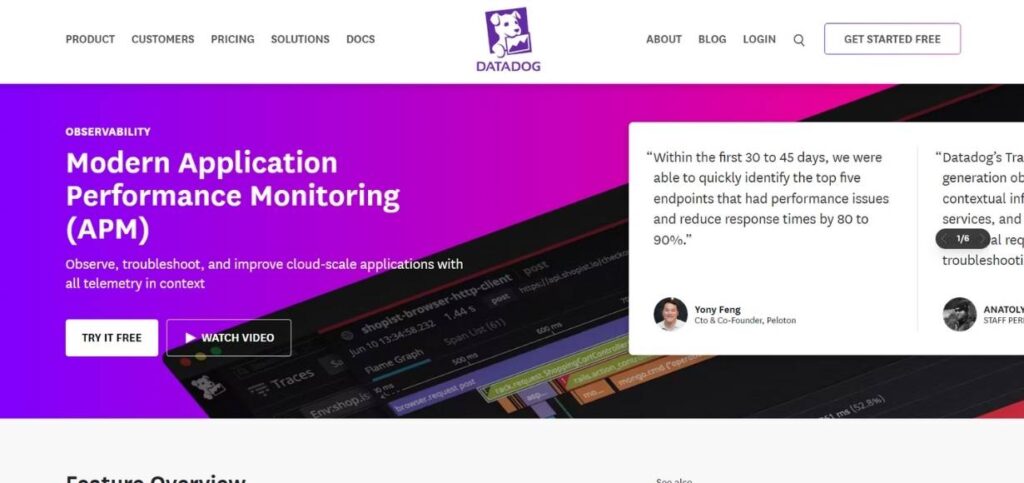
Datadog is a cloud-monitoring and security solution that provides real-time observability of applications, infrastructure, and logs. It supports distributed tracing, log management, and AI-driven anomaly detection. Datadog supports integration with cloud services, databases, and containerized environments to help DevOps teams identify performance bottlenecks and security risks. With its simple dashboard and alert feature, it is ideal for organizations of all sizes to attain application uptime and performance.
Key Features:
- Real-time application performance monitoring
- AI-powered anomaly detection
- Log management and analytics
- Seamless integration with cloud platforms and DevOps tools
Pros:
- Scalable for businesses of all sizes
- Extensive integrations with third-party tools
Cons:
- Can become expensive for larger teams
- Initial setup and customization require expertise
Pricing: Starts at $31 per host/month for APM & Continuous Profiler
Who Should Use It?
Best for DevOps teams, cloud-native businesses, and enterprises requiring real-time application insights.
2. New Relic

New Relic is a real-time performance monitoring and analytics-built full-stack observability platform. It provides application performance management (APM), infrastructure monitoring, log analysis, and distributed tracing. Developers and DevOps teams use it to identify issues, track deployments, and optimize applications for better efficiency. Its AI-powered insights provide proactive issue detection, reducing downtime. New Relic’s scalable architecture makes it perfect for enterprises that require detailed visibility into their application and infrastructure performance.
Key Features:
- End-to-end transaction tracing
- AI-driven root cause analysis
- Cloud and Kubernetes monitoring
- Custom dashboards and alerts
Pros:
- Intuitive UI and easy-to-use dashboards
- Powerful AI-based insights
Cons:
- High costs for large-scale deployments
- Can be overwhelming for beginners
Pricing: Free tier available; contact for pricing
Who Should Use It?
Ideal for developers, DevOps, and IT operations teams managing cloud and on-premises applications.
3. Dynatrace

Dynatrace is a platform for observability based on artificial intelligence providing intelligent and autonomous application monitoring. It provides insightful visibility into cloud-native applications, microservices, and container-based environments. Using automated dependency maps, real-time user monitoring, and anomaly analysis, Dynatrace assists in optimizing performance as well as reducing the time involved in troubleshooting. Its AI approach allows proactive fault resolution and root cause analysis and is best for companies with advanced IT infrastructures.
Key Features:
- AI-powered problem detection and auto-remediation
- Automatic dependency mapping
- End-user experience monitoring
- Kubernetes and cloud-native support
Pros:
- Excellent automation and AI-driven insights
- Auto-discovery of application components
Cons:
- Expensive for smaller teams
- Complex configuration for beginners
Pricing: Custom pricing
Who Should Use It?
Best for large enterprises, DevOps, and IT teams requiring deep observability.
4. AppDynamics
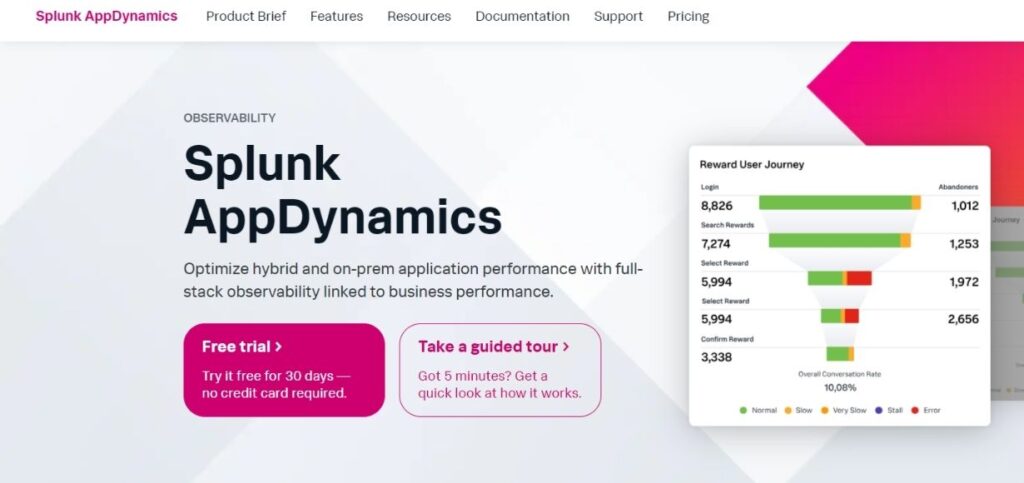
AppDynamics is a Cisco company, and it is a full-stack APM solution with real-time performance monitoring, business transaction monitoring, and machine learning-based anomaly detection. It gives end-to-end visibility into user experiences, infrastructure, and applications, enabling companies to enhance digital experiences. With auto-root cause analysis and machine learning-based insights, AppDynamics enables teams to identify performance degradation and optimize apps. It is also compatible with cloud platforms and perfect for companies that are in the process of migrating to cloud-native architecture.
Key Features:
- Real-time performance monitoring
- AI-driven root cause analysis
- Business transaction tracking
- Cloud and hybrid application support
Pros:
- Business-centric performance insights
- Strong integration with Cisco products
Cons:
- Higher cost for enterprise usage
- Steep learning curve for new users
Pricing: Custom pricing
Who Should Use It?
Best for enterprises and IT teams that need business impact monitoring.
5. SolarWinds AppOptics
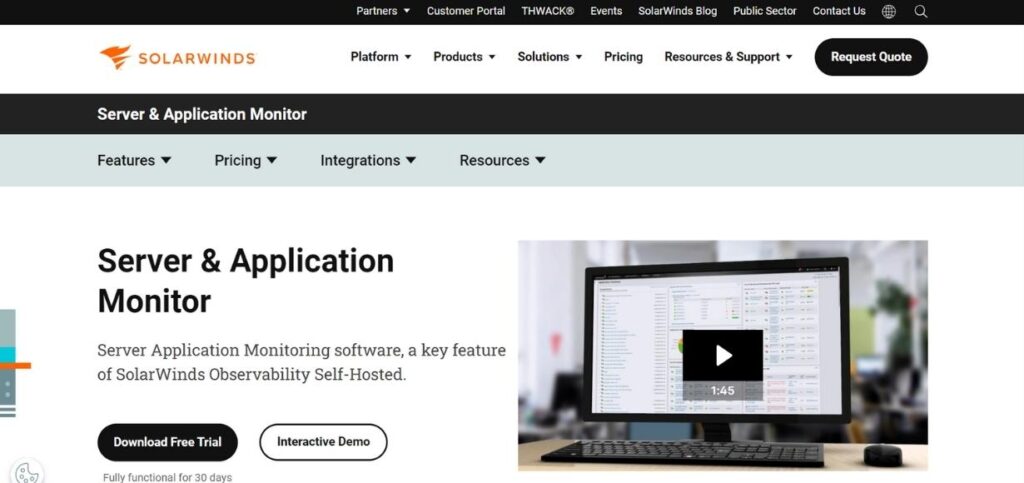
SolarWinds AppOptics is one of the best application monitoring tools that gives insights into distributed systems with deep visibility. It has real-time performance monitoring, anomaly detection, and custom metrics. AppOptics can monitor both cloud-based applications and on-premise applications, so it can be used with flexibility by organizations. With integration support for more than 150 tools and having no compatibility issues with DevOps tools, it allows effective troubleshooting and optimization and is a good fit for medium-sized businesses as well as large enterprises.
Key Features:
- Distributed tracing for microservices
- Customizable dashboards and alerts
- Cloud infrastructure monitoring
- AI-driven anomaly detection
Pros:
- Cost-effective compared to competitors
- Easy integration with cloud services
Cons:
- Limited automation features
- UI could be more modern
Pricing: Starts at $27.50 per host/month
Who Should Use It?
Best for small to mid-sized teams looking for an affordable monitoring solution.
Suggested Blogs:
6. Splunk APM
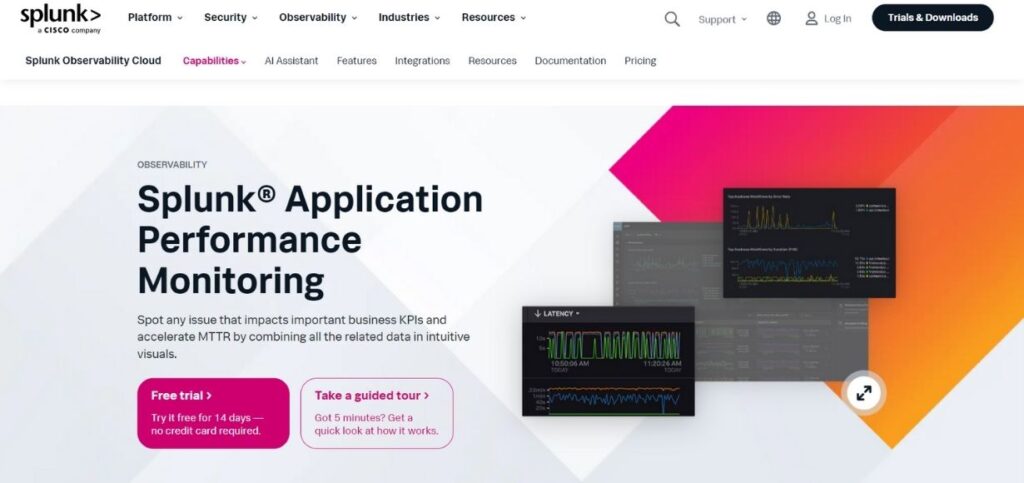
Splunk APM is a performance-oriented observability platform designed for next-gen applications. It provides real-time tracing, root cause analysis, and AI-driven insights to optimize application performance. Through its full-fidelity tracing and OpenTelemetry support, Splunk APM gives end-to-end visibility into cloud-native systems. The platform allows teams to quickly identify and resolve issues, reducing downtime and improving user experience. It is perfect for large enterprises that require deep observability in their distributed and microservices environments.
Key Features:
- AI-driven issue detection
- Real-time service dependency tracking
- OpenTelemetry support
- High-scale distributed tracing
Pros:
- Scales well for large enterprises
- Strong security and compliance features
Cons:
- Expensive for smaller teams
- Complex setup and configuration
Pricing: Custom pricing
Who Should Use It?
Best for large enterprises and security-conscious teams.
7. Prometheus
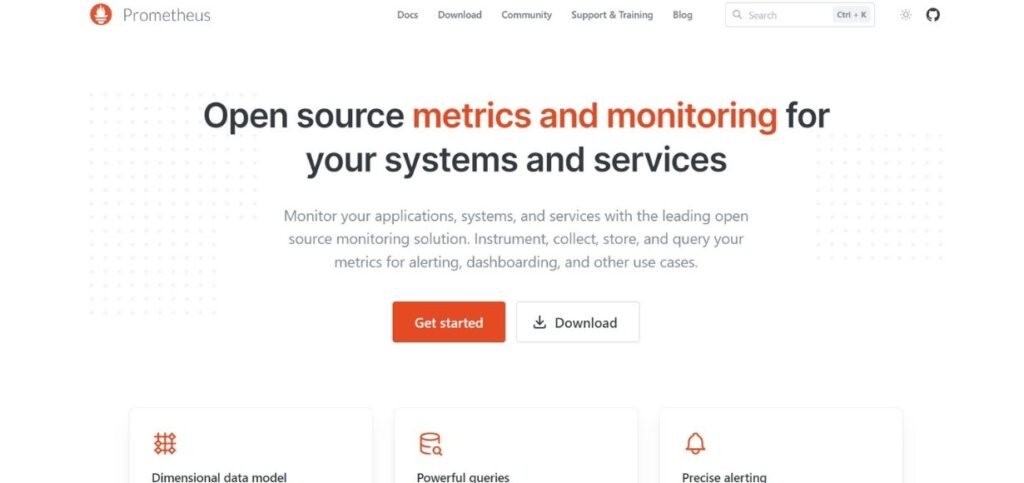
Prometheus is an open-source monitoring and alerting solution meant for cloud-native applications and containerized environments. It gathers time-series data with strong query capabilities, visualization features, and elastic alerting. Prometheus has native support for Kubernetes and is heavily used for infrastructure monitoring and performance tuning. Its scalability and high degree of open-source community involvement render it the go-to solution for DevOps teams and organizations that employ microservices-based architectures.
Key Features:
- Pull-based time-series monitoring
- Powerful query language (PromQL)
- Kubernetes and cloud-native support
- Integration with Grafana for visualization
Pros:
- Open-source and free to use
- Highly customizable for advanced users
Cons:
- Steep learning curve
- No built-in UI, requires external tools like Grafana
Pricing: Free (open-source)
Who Should Use It?
Best for DevOps and SRE teams working in cloud-native environments.
8. Grafana
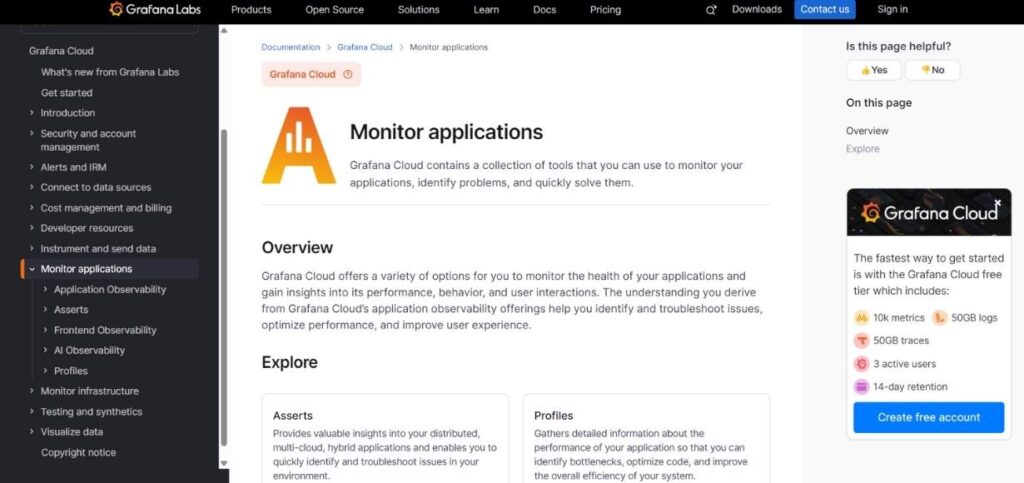
Grafana is a visualization and analytics solution that lets teams build personalized dashboards to monitor metrics across a range of data sources. Grafana works with Prometheus, InfluxDB, Elasticsearch, and other monitoring systems. With real-time analysis of application and infrastructure performance, it is a significant asset to both DevOps and IT ops teams. Flexibility, the strength of visualization tools, and support via community-contributed plugins rank it as an absolute favorite with organizations that require complete performance understanding.
Key Features:
- Customizable dashboards and alerts
- Integrates with Prometheus, Elasticsearch, and more
- Supports multiple data sources
- Community plugins for extended functionality
Pros:
- Free and highly customizable
- Supports various data sources
Cons:
- Requires manual setup and configuration
- No built-in alerting (requires additional setup)
Pricing: Free (open-source), plan starts at $19/month
Who Should Use It?
Ideal for teams needing a powerful and flexible monitoring dashboard.
9. Nagios
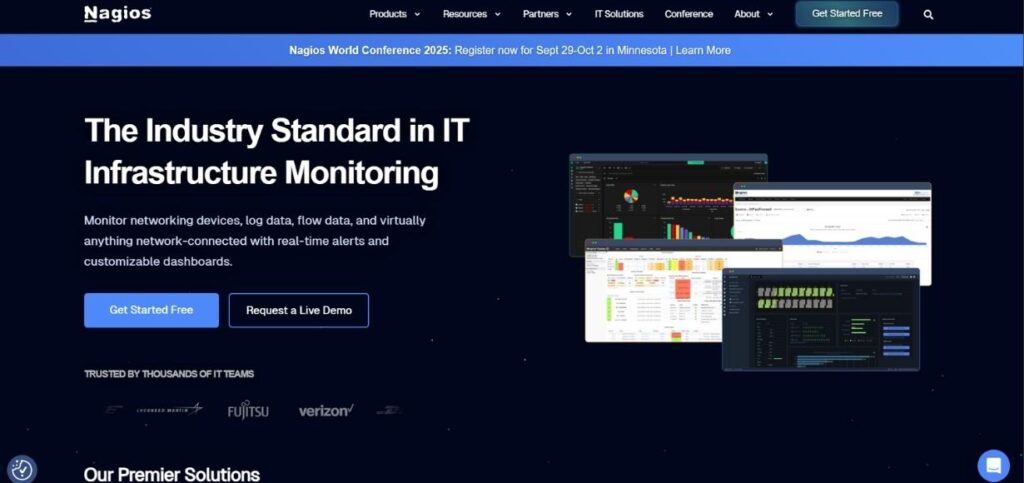
Nagios operates as one of the best application monitoring tools which enables businesses to monitor server health together with application performance and network operations. The system delivers active notifications while conducting complete log examinations so users can identify and block hardware breakdowns in real-time. The extensive plugin collection of Nagios enables its users to monitor different types of IT assets. The solution works best for organizations that need a budget-friendly monitoring system which gives good flexibility and has strong backing from the community.
Key Features:
- Centralized monitoring for IT infrastructure
- Customizable alerts and notifications
- Extensive plugin support
- Performance and availability tracking
Pros:
- Free and highly extensible
- Strong community support
Cons:
- Outdated UI
- Requires manual configuration for advanced features
Pricing: Free (Nagios Core), paid plans start at $2,495 for 100 nodes
Who Should Use It?
Best for system administrators and IT teams managing on-prem infrastructure.
10. Zabbix

Zabbix is a commercial-grade, open-source monitoring solution that gives real-time insight into servers, networks, and applications. With automatic detection, customizable notifications, and detailed reports, IT groups can rapidly locate and correct performance problems. It is renowned for its scalability, making it scalable for businesses ranging from small startup companies to multinational corporations. It supports numerous technologies and provides robust security options, making it an ideal choice for organizations that are looking for an efficient, adaptable, and economical monitoring tool for their IT environment.
Key Features:
- Real-time metrics collection
- Custom alerting and automation
- Cloud and on-premise monitoring
- Distributed monitoring with proxies
Pros:
- Free and open-source
- Scales well for large enterprises
Cons:
- Complex setup and maintenance
- Requires manual tuning for optimal performance
Pricing: Free (open-source)
Who Should Use It?
Best for enterprises looking for a powerful open-source solution.
11. Instana
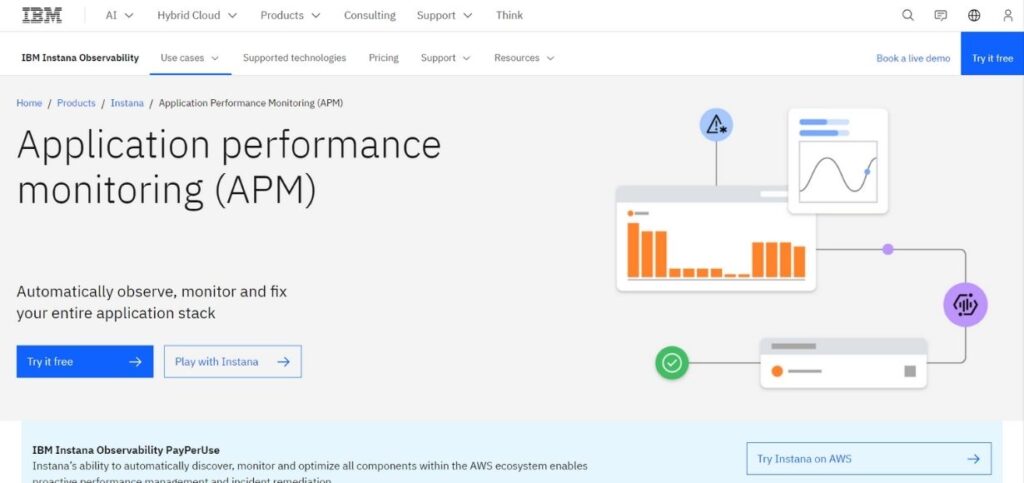
Instana is an artificial intelligence (AI)-powered application performance monitoring (APM) solution for modern cloud-native applications. Instana provides automatic instrumentation, distributed tracing, and real-time anomaly detection. Instana continuously collects data in real time across applications, microservices, and containers with deep observability and minimal setup. With native Kubernetes, hybrid cloud, and DevOps support, Instana is especially designed for enterprises that need automated monitoring and intelligent insights to ensure optimal application performance and availability.
Key Features:
- Automatic discovery and monitoring of microservices
- AI-driven root cause analysis
- Distributed tracing with high granularity
- Kubernetes and containerized application support
Pros:
- Fully automated observability with minimal manual setup
- Real-time monitoring with low latency
Cons:
- Expensive for smaller businesses
- Can be complex for new users
Pricing: Custom pricing based on usage
Who Should Use It?
Best for DevOps teams, SREs, and enterprises managing complex microservices architectures.
12. LogicMonitor
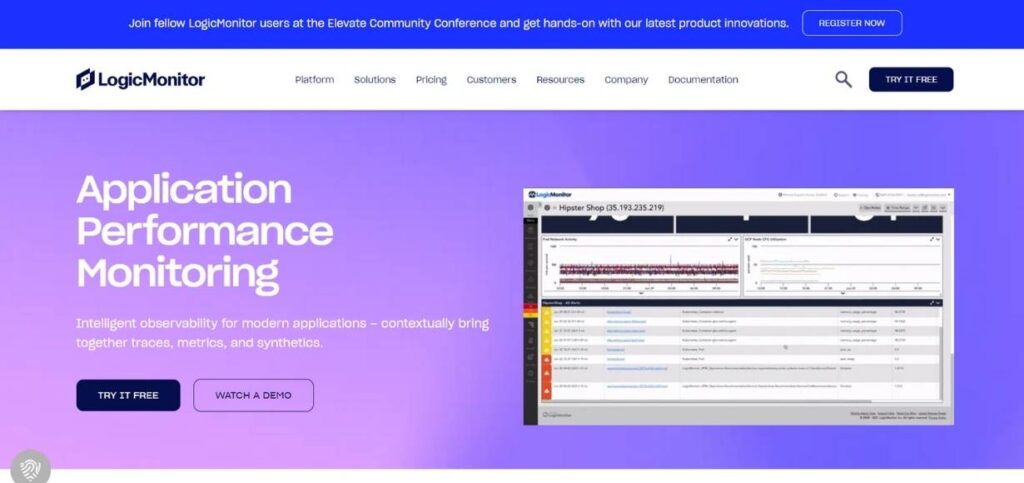
LogicMonitor is a cloud-based monitoring solution that provides end-to-end insight into applications, networks, servers, and cloud services. With automated discovery, predictive analytics, and AI-driven insights, IT organizations can identify and avoid performance problems. With natively integrated AWS, Azure, Google Cloud, and on-premises infrastructure support, LogicMonitor helps organizations monitor hybrid IT environments effectively. Its smart alerting, customizable dashboards, and detailed reporting are all reasons why it’s one of the best application monitoring tools among enterprises when enterprises need to improve operational efficiency, reduce downtime, and maximize resource utilization on their IT infrastructure.
Key Features:
- Automated discovery of applications and infrastructure
- Customizable dashboards and alerts
- AIOps-powered anomaly detection
- Strong multi-cloud support
Pros:
- Easy to deploy with minimal configuration
- Supports a wide range of integrations
Cons:
- Higher pricing for enterprises
- Limited automation features compared to competitors
Pricing: Custom pricing based on infrastructure size
Who Should Use It?
Best for IT operations teams managing hybrid and multi-cloud environments.
13. Sematext APM

Sematext APM is a complete-stack application performance monitoring solution that provides real-time visibility into application health, infrastructure performance, and logs. It includes auto-discovery of services, distributed tracing, and alerting to enable teams to quickly identify and fix performance bottlenecks. Sematext is cloud-agnostic and supports cloud infrastructure platforms, microservices-based architectures, and DevOps tools and is perfect for agile teams looking for an integrated observability solution. Its easy-to-use dashboards, adaptable pricing, and elastic monitoring make it a favorite among startups, enterprises, and mid-market businesses seeking in-depth app insights.
Key Features:
- Application and infrastructure monitoring
- Log management and analytics
- Real-time distributed tracing
- Custom alerting and anomaly detection
Pros:
- Affordable pricing for small and mid-sized teams
- Easy integration with DevOps tools
Cons:
- Limited features for large-scale enterprises
- Requires manual setup for advanced configurations
Pricing: Separate pricing for each type of application type is available
Who Should Use It?
Best for startups and mid-sized companies looking for a budget-friendly monitoring solution.
14. ManageEngine Applications Manager
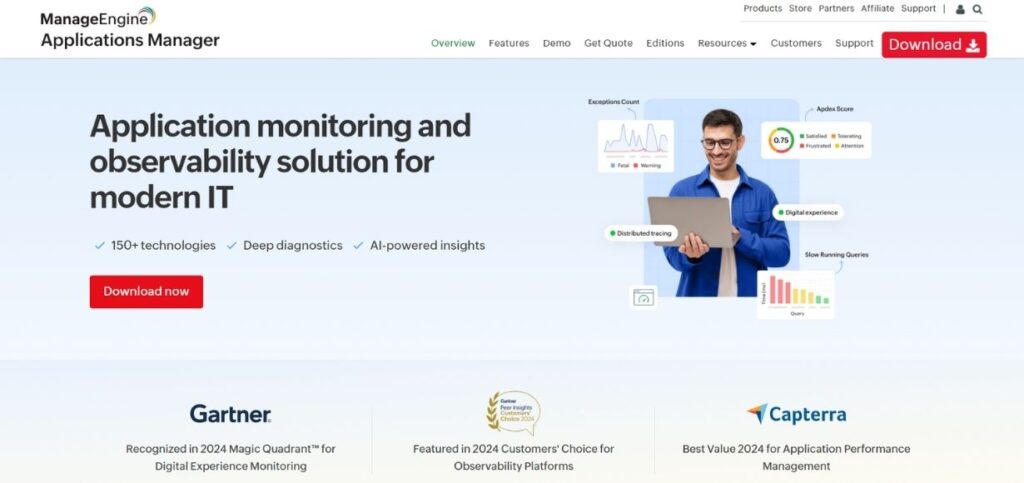
ManageEngine Applications Manager is an enterprise-level application, database, and cloud service monitoring solution. It provides end-to-end visibility into performance metrics, predictive alerts, and root cause analysis. Having both on-premises and cloud support, it is used extensively by IT operations teams to monitor applications, debug, and plan capacity. Being simple and having extensive integration capabilities, it is an attractive solution for organizations seeking an end-to-end monitor solution.
Key Features:
- End-to-end application performance monitoring
- Cloud and database performance insights
- AI-powered anomaly detection
- Custom reports and SLA management
Pros:
- Cost-effective for small and mid-sized businesses
- Easy-to-use interface with robust reporting
Cons:
- Limited automation capabilities
- UI could be more modern
Pricing: Starts at $395 per year for up to 10 monitors
Who Should Use It?
Best for IT administrators and mid-sized businesses needing an all-in-one monitoring tool.
Comparison Between Best Application Monitoring Tools
Here’s a comparison table of the best application monitoring tools, including features, pricing, use cases, and official websites.
| Tool | Key Features | Pricing | Best For | Website |
| Datadog | APM, log management, security monitoring, cloud monitoring, AI-powered alerts | Starts at $15/month per host | Cloud applications, DevOps, enterprise IT | datadoghq.com |
| New Relic | Full-stack observability, distributed tracing, AI-driven insights, logs | Free for basic, contact for pricing | Developers, DevOps, SRE teams | newrelic.com |
| Dynatrace | AI-powered observability, real-time automation, Kubernetes monitoring | Custom pricing | Enterprises, cloud-native applications | dynatrace.com |
| AppDynamics | Business transaction monitoring, root cause analysis, AI-powered performance insights | Custom pricing | Enterprise applications, digital transformation | appdynamics.com |
| SolarWinds AppOptics | Application and infrastructure monitoring, distributed tracing, anomaly detection | Starts at $27.50/month per host | SMBs, cloud and hybrid environments | solarwinds.com/appoptics |
| Splunk APM | Full-fidelity tracing, OpenTelemetry support, machine learning-powered alerts | Custom pricing | Enterprises, cloud applications, security teams | splunk.com |
| Prometheus | Open-source monitoring, time-series database, Kubernetes monitoring | Free | Cloud-native applications, DevOps teams | prometheus.io |
| Grafana | Data visualization, alerting, dashboard creation, integration with Prometheus | Free (open-source), paid plans start at $19/month | IT monitoring, analytics, DevOps teams | grafana.com |
| Nagios | Network monitoring, log management, infrastructure health checks | Free (Nagios Core), paid plans for Nagios XI start at $2,495 for 100 nodes | IT infrastructure monitoring, small to large businesses | nagios.org |
| Zabbix | Open-source monitoring, auto-discovery, customizable alerts, strong security | Free | IT operations, enterprises, service providers | zabbix.com |
| Instana | AI-powered APM, automated observability, Kubernetes and microservices monitoring | Custom pricing | Enterprises, cloud-native businesses | instana.com |
| LogicMonitor | Automated IT infrastructure monitoring, AIOps, cloud/hybrid support | Custom pricing | Enterprises, IT operations teams | logicmonitor.com |
| Sematext APM | Real-time application performance monitoring, distributed tracing, log management | Separate pricing for each type of application type is available | Startups, SMBs, DevOps teams | sematext.com |
| ManageEngine Applications Manager | End-to-end application monitoring, capacity planning, real-time alerts | Starts at $395/year | Enterprises, IT operations, business applications | manageengine.com |
Conclusion
Choosing the best application monitoring tool depends on your company’s needs, whether real-time performance monitoring, security monitoring, or deep analysis. For companies that need end-to-end APM, Datadog, New Relic, and Dynatrace provide strong AI-driven insights, scalability, and native integration. For open-source options, Prometheus, Grafana, and Zabbix provide cost-effective monitoring with manageable customization.
For compliance and security being the top priority for organizations, Splunk APM and AppDynamics offer advanced anomaly detection and logging analysis. For small to medium-sized businesses, ManageEngine Applications Manager and Sematext APM are the choices, where cloud-native monitoring requirements are fulfilled with SignalFx or LogicMonitor.
In the end, the ideal tool is something that best addresses your infrastructure, cost, and monitoring needs. Obtaining the best application monitoring tool ensures faster performance, lesser downtime, and enhanced user satisfaction.
FAQs
1. What is an application monitoring tool and why is it there?
An application monitoring tool supports real-time tracking of the health, performance, and availability of applications. It is needed to discover and fix the problems before users are impacted by them, make the system’s performance better, and ensure the user experience does not get bogged down.
2. What are the key features of the best application monitoring tool?
Advanced features in the best application monitoring tools include real-time performance monitoring, anomaly detection, root cause, logging, and DevOps integration tool support as well as programmatic alerting for maximizing downtime and system resilience.
3. What is the best application monitoring tool which is cloud-based that meets the requirement?
Cloud-enabled application masters with analytics through AI, scalability, and integrations that are deep-running for multi-cloud monitoring needs and hybrid environment monitoring needs.
4. Are open-source or free app monitoring tools out there?
And, of course, there are even open-source equivalents such as Prometheus, Grafana, Zabbix, and Nagios that bring serious monitoring horsepower with a whole lot of monitoring infrastructure, and the app might but with the cost of requiring more to be manually installed.
5. How do application monitors benefit DevOps teams?
The features also include the integration feature of CI/CD pipelines, performance monitoring, auto-exception finding, and forward debugging to enable the DevOps teams to accelerate the application as well as deploy it with ease.

